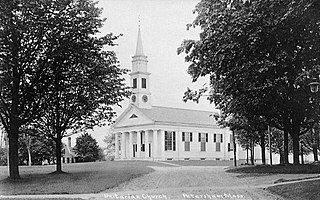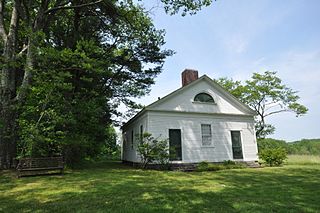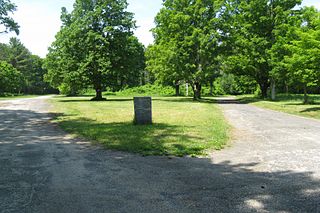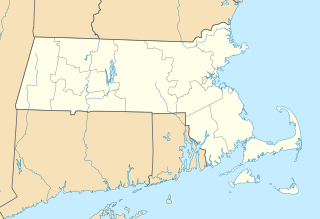
Petersham is a town in Worcester County, Massachusetts, United States. The population was 1,234 at the 2010 census. Petersham is home to a considerable amount of conservation land, including the Quabbin Reservation, Harvard Forest, the Swift River Reservation, and Federated Women's Club State Forest.

The Quabbin Reservoir is the largest inland body of water in Massachusetts, and was built between 1930 and 1939. Today, along with the Wachusett Reservoir, it is the primary water supply for Boston, some 65 miles (105 km) to the east as well as 40 other communities in Greater Boston. It also supplies water to three towns west of the reservoir and acts as backup supply for three others. By 1989, it supplied water for 2.5 million people, which was about 40% of the state's population at the time. It has an aggregate capacity of 412 billion US gallons (1,560 GL) and an area of 38.6 square miles (99.9 km2).

Prescott was a town in Hampshire County, Massachusetts. It was incorporated in 1822 from portions of Pelham and New Salem, and was partially built on Equivalent Lands. It was named in honor of Colonel William Prescott, who commanded the American forces at the Battle of Bunker Hill. It was disincorporated on April 28, 1938, as part of the creation of the Quabbin Reservoir. It was the least populous of the four unincorporated towns, with barely 300 residents by 1900. Upon dissolution, portions of the town were annexed to the adjacent towns of New Salem and Petersham. The majority of the former town is still above water, and is known as the Prescott Peninsula. The public is not allowed on the peninsula except for an annual tour given by the Swift River Valley Historical Society, or for hikes conducted by the Society. None of the land is in Hampshire County any longer; the New Salem portion is in Franklin County; and the Petersham portion is in Worcester County.

Dana was a town located in Worcester County, Massachusetts. Dana was lost as a result of the formation of the Quabbin Reservoir.

Gay Farm is a historic colonial house located on the north side of Nichewaug Hill in Petersham, Massachusetts. Built in 1740 by William Negus, the house is the oldest surviving building in Petersham. Negus' family owned the home until 1819, when Joel Stearns purchased the property. Thomas Stevens Howe, great grandson of William Negus, purchased the home in 1847 and lived there until his death in 1893. His daughter Elizabeth and her husband Charles M. Gay lived in the house during their lifetimes, giving it its current name. Not having any children, the home then passed to their relative Lewis H. Babbitt and his wife Corinne who lived out their lives there.

Phillipston Center Historic District encompasses the historic village center of Phillipston, Massachusetts. The town was first settled in 1751 on land grants made in the 1730s, and was incorporated as a separate town in the 1770s. The surviving village center is not far from the location of the first settlement, which eventually came to include a tavern. After incorporation the center developed around what is now the junction of the Baldwinville, Petersham, and Templeton Roads, although this took time, possibly because of difficulties associated with the American Revolutionary War. As a result, the district has relatively few properties that date to the 18th century. All of these are modest vernacular residential structures. The town grew only modestly until 1830, after which time its population declined, not reaching the same level until 1980, 150 years later. As a result of the lack of growth, most of the properties in the district are Federal and Greek Revival in character. Many of the institutional buildings in the center date to the late 19th and early 20th centuries. The district was added to the National Register of Historic Places in 1999.

The Ames Schoolhouse is a historic school building at 450 Washington Street in Dedham, Massachusetts. It was originally part of the Dedham Public Schools. It currently serves as the town hall and senior center for the Town of Dedham.

The Holland–Towne House is a historic house in Petersham, Massachusetts. Built in c. 1752 by Jonas Holland, it is one of the town's four surviving colonial-era houses. It was listed on the National Register of Historic Places in 1990.

The Petersham Common Historic District encompasses the historic town center of Petersham, Massachusetts. Laid out in 1733 and centered on the town common bounded by Main and Common Streets, it retains most of its 19th-century character, with only a few turn-of-the-20th-century civic buildings adding later character. The district was added to the National Register of Historic Places in 1982.

Hancock Town Hall is a historic town hall on Massachusetts Route 43 in Hancock, Massachusetts. It was constructed in the Greek Revival style c. 1852, using timbers from a previous meeting house. The building served a number of municipal purposes, including library, school, town offices, and town meeting space. In preparation for the town's celebration of the nation's bicentennial, the hall was moved in 1975 to a lot adjacent to the town cemetery and restored. The hall was listed on the National Register of Historic Places in 1973. After being delisted for being moved, it was relisted in 1975.

The Old Town Hall is a historic town hall building at 10 Kendal Road in Tyngsborough, Massachusetts. The wood frame building was built in 1834 as a church to house the local Baptist congregation, a role it served until 1857, when it was sold to the town. The styling of the building is predominantly Federal, although its cupola is a late 19th-century Colonial Revival addition. The building was listed on the National Register of Historic Places in 2005.

The Common Historic District is a historic district encompassing the civic and institutional heart of Reading, Massachusetts. The district is centered on the town common, at the intersection of Main and Salem Streets. The common has been communally owned since at least 1737, with the original burying ground to the north. In 1769 the area's first meeting house was built, giving the area a sense of identity separate from portions of Reading that would later be set off as Wakefield and North Reading. Since then the area has become a focal point for religious and civic institutions in the town.

The Edwin Bassett House is a historic house in Reading, Massachusetts. It is a well-preserved Greek Revival house, built in 1850 by Edwin Bassett, the first Reading shoemaker to install a McKay stitching machine, a device that revolutionized and led to the industrialization of what was before that a cottage industry. The house was listed on the National Register of Historic Places in 1984.

The former Reading Municipal Building is a historic building at 49 Pleasant Street in Reading, Massachusetts. Built in 1885, this two-story brick building was the town's first municipal structure, housing the town offices, jail, and fire station. In 1918 all functions except fire services moved out of the building. It now serves as Reading's Pleasant Street Senior Center. The building was listed on the National Register of Historic Places in 1984.

The Common District encompasses the main civic center of Wakefield, Massachusetts. It is centered on the historic town common, just south of Lake Quannapowitt, which was laid in 1644, when it became the heart of Old Reading. The area was separated from Reading as South Reading in 1818, and renamed Wakefield in 1868. The 25 acre district includes the buildings that line the common on Common Street and Main Street, which include the town hall, public library, YMCA, post office, and several churches. It was listed on the National Register of Historic Places in 1990.

The Sharlot Hall Museum is an open-air museum and heritage site located in Prescott, Arizona. Opened in 1928 by Sharlot M. Hall as the Gubernatorial Mansion Museum, the museum that now bears her name is dedicated to preserving the history and culture of the Central Highlands of Arizona.

The 6th Avenue Hotel - Windsor Hotel, now known as the New Windsor Hotel, is the only 19th century hotel which is still in use in the Phoenix, Arizona, original town-site. It is listed in the National Register of Historic Places.

The District No. 5 School is an historic school building and local history museum at 311 East Road in Petersham, Massachusetts. It is one of two relatively unmodified one-room schoolhouses in the town that were built in 1849. It is presently managed by the local historical society as a local history museum. The building was listed on the National Register of Historic Places in 2016.

The District No. 4 School, also known as the First East School or Ledgeville School, is an historic school building at 191 East Road in Petersham, Massachusetts. Built in 1846, it is one of the town's older surviving district school buildings, and now serves as a local community hall. It was listed on the National Register of Historic Places in 2016.






















